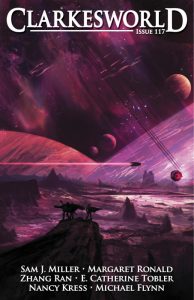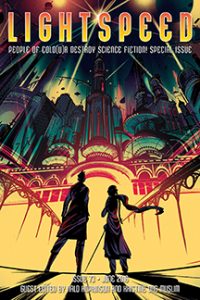
Welcome back to Words for Thought! This time around, I'll discuss five recent stories that speak to me, and to each other through the common themes of destiny and disguises.
Sam J. Miller's "Things With Beards" from the June 2016 issue of Clarkesworld is in direct conversation with John W. Campbell's Who Goes There? famously made into the movie The Thing by John Carpenter. Miller updates the tale, setting it in 1980s against the backdrop of the AIDS crisis. The tale centers on MacReady, recently back from Antarctica where something terrible happened that he can't quite remember. The crew at McMurdo Station was found brutally ripped apart with no apparent explanation. Only MacReady and his for-now lover, Childs, were spared the carnage. Their bodies were found perfectly preserved and frozen on the edge of the chaos. This information is related in a straightforward manner, despite MacReady walking around, very much alive. Rather than attempting a shocking twist, Miller is upfront about the fact that MacReady is not MacReady. The twist, for lack of a better word, is that the thing wearing MacReady as a disguise truly believes it is MacReady, with all his memories and passions. What sets Miller's story apart is the way it deals with questions of self and identity. Who Goes There? is laced with paranoia; anyone could be a monster under their skin. In Things With Beards, Miller takes on queer identity, passing privilege, and racism. MacReady and many of the other men at McMurdo presented themselves as aggressively masculine and heterosexual, leaving MacReady to wonder how many of them — like himself — were wearing disguises. Flipping the story, and telling it from the perspective of "anyone could be like me" as opposed to "anyone could be against me" is an innovative take on Campbell's tale. There are echoes of the original as MacReady speculates on who might be an undercover cop at a rally against police brutality directed at the black community. However the primary focus of "Things With Beards" is not "how do you identify your enemy when everyone looks just like you," it's "how do you identify your allies when everyone looks like someone who might turn against you." The looming shadow that AIDS cast over the story circles back to the notion of the enemy within; your own body could turn traitor on you at any moment. As is typical of Miller's work, "Things With Beards" delivers a satisfying emotional punch, and serves as an excellent example of contemporary fiction in conversation with a SFF classic.
"The Drowning Line" by Haralambi Markov from Issue 10 of Uncanny Magazine opens with the protagonist, Reinhart, waking waist-deep in water, uncertain of where he is or how he got there. As he waits for his husband to pick him up, Reinhart is visited by his distant ancestor, Hartrich the Drowned, and they have a brief, intense sexual encounter that leaves Reinhart shaken. This opening brings to mind Isabel Yap's "A Cup of Salt Tears" with its mix of desire, water, guilt, and fear, but Markov's story follows a different path. Reinhart's encounters with Hartrich are a matter of compulsion, not longing. His family line is cursed, nearly all of them drowning at Hartrich's hand in revenge for his own drowning centuries ago. Seen in this light, the sex between Hartrich and Reinhart reads more like a metaphor for the seductive idea of drowning, giving up, letting go. Reinhard's ghost might well be deep-seated depression, a chemical imbalance, and drowning might be his escape.
A haunting lasts forever. It's erosion of the mind, a wearing of the heart — meticulous and slow in perforating reality.
Markov skillfully weaves threads of doubt throughout the narrative, but whether it's chemical or supernatural, the result is the same. Reinhart feels trapped by what he believes to be his destiny; his life is not his to control. Markov treats the reader to gorgeous language and imagery throughout, but like dead things drifting beneath the water, darkness lurks under the surface. The horror in this story is subtle, but effective, exploring the question of fate and free will from a fresh perspective.
"Wednesday's Story" by Wole Talabi from the May 2016 issue of Lightspeed looks at the idea of destiny from a different angle — that of a storyteller trying to change the course of the tale. The framing device is reminiscent of Neil Gaiman's "October in the Chair," with a group of storyteller-siblings swapping stories. Instead of personified months, as in Gaiman's story, Talabi gives us personified days of the week, linking the storytellers directly to their chosen story, that of Solomon Grundy.
Solomon Grundy,
Born on a Monday,
Christened on Tuesday,
Married on Wednesday,
Took ill on Thursday,
Grew worse on Friday,
Died on Saturday,
Buried on Sunday.
That was the end,
Of Solomon Grundy
One of the siblings, Wednesday, throws herself quite literally into Grundy's tale, trying to change the course of the story and give him a happier ending. Her siblings are determined to stop her, believing the story is set and cannot be changed. At its heart, "Wednesday's Story" is a story about stories, with several nested inside the primary tale of Solomon Grundy, which in turn is nested within Wednesday's journey in the framing device. Talabi addresses the power of narrative itself, and the nature of tales told and retold over generations. How much power does the teller, or the author have over a tale? Are certain things inevitable; must the story always take a certain course, or can the characters or the narrator shift the action? Bringing it to a meta level, "Wednesday's Story" raises the question of who stories belong to — those telling them, those living them, or those consuming them? Once a story leaves an author's hand, does it become fair game, open all reader/reviewer interpretations, or is there one true version of the tale shaped by the author's intent?
Abhishek Bhatt's "Choose Your Killer" from the June 2016 issue of Mithila Review posits the future of entertainment as interactive movies tailored to each individual viewer. Agami has seen the season's biggest release three times, a mystery where the audience chooses the ending by selecting which of three suspects they believe to be responsible for the brutal killing of a cat. After five seconds of uninterrupted attention focused on their chosen killer, the viewer sees their own personal ending, validating their choice. After experiencing each of the three possible endings, Agami receives an invitation to a special screening where the viewer doesn't have to do anything at all. The new and improved Spectaculus HX3 headset will do all the work, reading viewers' thoughts and providing them with their desired ending. Agami attends the special showing, but finds the ending different from the one he intended. He tries again, but each time the ending is different than the one he chose. He contacts a Spectaculus customer service rep who smirkingly informs him that the technology works for everyone else. Paranoia sets in and Agami starts wondering whether he has free will and the ability to choose after all. He decides ultimately there are no rules constraining society, and he should live entirely in the moment. He dumps his girlfriend, quits his job, and even begins defecating in public. Eventually, his cat is found murdered, and due to his erratic behavior, he is the prime suspect. Naturally, the courtroom where he's tried is fully equipped with Spectaculus HX3 headsets, implying Agami's guilt will be determined by popular opinion. Like Talabi and Markov's stories, Bhatt's story questions the power individuals have over narrative, and examines the power narratives have over individuals. After multiple attempts to impact the story on screen, it is Agami himself who is taken over by the story, repeating — it seems — the central crime, and finding his life ruined. Did he ever have any power at all, or was everything predetermined by the hand of some outside author, controlling his life and directing his every action? "Choose Your Killer" falls closer to flash length than short story, but Bhatt packs quite a few intriguing ideas into the tale, and offers an interesting take on destiny and free will.
"Salto Mortal" by Nick T. Chan from Lightspeed's People of Colo(u)r Destroy Science Fiction issue deals with a different kind of freedom, and plays on the theme of disguise versus true self, as seen in Miller's "Things With Beards." Rather than being controlled by the unseen hand of destiny, Mary is controlled directly and violently by her husband, Paul. He beats her, and monitors all her activities via smartwatch, cameras, and drones. All the while, he does his best to convince her she should be grateful. She's a refugee from a Mexico that no longer exists. Aliens arrived on Earth several years ago, engulfing Mexico in a purple fog, and everyone caught on the other side of the wall separating Mexico and the US is presumed dead. Mary has no family to go back to, and she's begun to lose her Spanish through disuse as well. Even her name isn't her own. Marquetta became Mary at Paul's insistence; her entire life is defined and constrained by him. The only bit of her heritage she's held onto is her love of lucha libre wrestling matches, and it's a dream of the matches she used to watch with her family that gives Mary the courage to try to leave her husband. Her plans are derailed when she encounters one of the aliens disguised as a young boy. The theme of identity and disguise recurs several times throughout the story — Mary's loss of herself and her heritage, the aliens' attempts to imitate human beings, and the masks and personas the luchadors adopt in the ring. In "Salto Mortal," masks can hide a true identity, but they can be dangerous as well. In the case of the aliens, their imperfect imitation of human beings gives them away and puts them at risk for capture and dissection. In Paul's case, his mask is the kind and caring nature he projected when Mary first met him, hiding his true monstrous self underneath. "Salto Mortal" is by turns heartbreaking and hopeful, but above all it feels deeply grounded. Mary's fears are realistically painted, and her choices throughout the story are rooted in her character. She refuses to be a victim of narrative destiny, and reclaims her story for her own.













